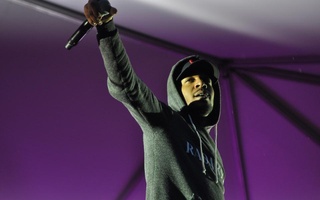“People, the revolution will not be televised / the revolution is in your mind / the revolution is here / this is my coup d’état,” raps hip-hop artist G-Dragon in the title track of his sophomore album, “Coup D’état.” A collaborative effort with famed producers Diplo and Baauer, the eerie, thumping song takes listeners by surprise, devoid of the frenetic beats fans have come to associate with these producers. And indeed, G-Dragon delivers what he promises, becoming one of the first Korean artists since Psy to not only top Korean chart records, but also to break into the U.S. Billboard Top 200.
There have been numerous efforts, collaborations, and concerts by other Korean pop artists to reach out to the U.S. audience. Sadly, many efforts have come and gone like a one-hit wonder, such as girl group f(x) and their brief stint of fame with their performance at the 2013 SXSW festival and their “Funny or Die” skit with Anna Kendrick. Still other attempts have failed entirely. So how is it that G-Dragon – a slender man of 5’8” build who cannot speak fluent English – has been able to create a name for himself in the U.S. music scene and even amongst acclaimed artists like Pharrell or Diplo?
Consider K-pop girl group T-ara and their recent performance in Las Vegas. In a poor attempt to gain U.S. recognition and fans, the girls were flown to perform at a Las Vegas resort alongside Chris Brown, who they publicized as their “close friend” in the U.S. pop industry. When the girls began their performance, however, they were cut off midway by Brown himself, who decided to take center stage. They were completely humiliated in the U.S. and even mocked by their fans back home, for their attempted and failed foray into the U.S. market. There was clearly very little substance behind this “friendship” between the artists, and moreover, the gig seemed completely irrelevant with the other aspects of their comeback promotions at the time.
Contrast this experience with G-Dragon’s collaboration with the likes of Missy Eliott on the song “늴리리야 (Niliria)” and with Sky Ferreira on the song, “Black.” Instead of trying to piggyback off of the fame of other artists, G-Dragon selects artists whom he personally respects—even if they may not be the most popular artists at present—and then collaborates with them. As opposed to other collaborations in which featured artists often barely have air time, G-Dragon splits the track evenly with his collaborative partners, even writing each song to suit their respective styles, while remaining true to his own flavor. The result of this process is an authentic track that does not seem forced or reminiscent of blatant noise marketing. Additionally, G-Dragon’s native fans enjoy the experience of being introduced to Western artists whom they might not necessarily know. This only elevates G-Dragon’s status as one who goes against the grain within the greater K-pop industry, and thus his status as an “icon.” It’s a win-win situation.
Furthermore, whereas the over-zealous obsession with “Gangnam Style” ended up reducing Psy’s artistry to comedic gimmicks, G-Dragon’s carefully styled music videos, choreography, and even attire for each new release exude a sense of artistry. In other words, while both Psy and G-Dragon were most likely perceived as “others” by a vast majority of the general U.S. public, G-Dragon harnesses this “otherness” into fresh intrigue, with his avant-garde wardrobe boasting high-end designers (often photographed in Saint-Laurent) or overly loud, nearly bizarre styles. This is in sharp contrast from the bubblegum colored suit jackets, sunglasses, and over-the-top behavior that reduced Psy’s “otherness” to strange comedy. Both are solo rappers who write their own lyrics—and under the same entertainment agency no less – but this different method of packaging their music creates an ever-widening gap between the two artists.
But perhaps most notable is G-Dragon’s ability to separate his artist persona from his real self, Kwon Ji-Yong. He wears many hats, and with a loud boldness each time. Whether he plays a b-boy with dreadlocks, a psychedelic clown, an angst-y urban teen, or even a reincarnation of himself, he continues to keep fans intrigued and on their toes. This constantly evolving style fascinates viewers similar to the way Lady Gaga’s constant transformation keeps fans wondering how she will present herself next. Perhaps it is this elevated element of carefully crafted performance that allows for a foreign artist to gain intrigue in the U.S. music scene, without having to bare all on a wrecking ball.
—Columnist Soy Kim can be reached at soyoung.kim@thecrimson.com.
Read more in Arts
The Love Song of An Awkward PrefroshRecommended Articles
-
High Art“Up until LSD, I never realized that there was anything beyond this normal working state of consciousness,” George Harrison famously said in 1987.
-
 The Girl with the Dragon Tattoo
The Girl with the Dragon Tattoo -
 How to Train Your Dragon
How to Train Your Dragon -
 Day or Nite, Yardfest Does Not Entertain
Day or Nite, Yardfest Does Not Entertain -
 Harvard Student Art Show
Harvard Student Art Show -
 Studying with Movie Scores
Studying with Movie Scores














